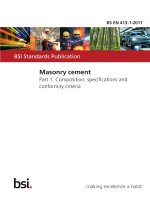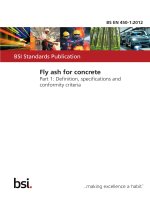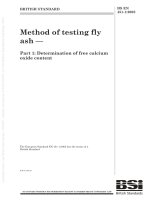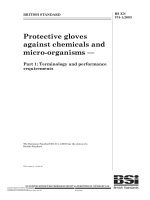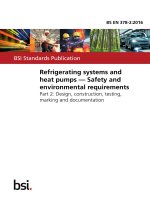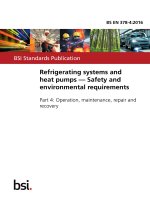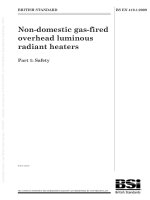Bsi bs en 62087 1 2016
Bạn đang xem bản rút gọn của tài liệu. Xem và tải ngay bản đầy đủ của tài liệu tại đây (1.04 MB, 20 trang )
BS EN 62087-1:2016
BSI Standards Publication
Audio, video, and related
equipment — Determination
of power consumption
Part 1: General
BS EN 62087-1:2016
BRITISH STANDARD
National foreword
This British Standard is the UK implementation of EN 62087-1:2016.
It is identical to IEC 62087-1:2015. Together with BS EN 62087-2,
BS EN 62087-3:2016, BS EN 62087-4:2016, BS EN 62087-5:2016 and
BS EN 62087-6:2015 it supersedes BS EN 62087:2012 which will be
withdrawn on 19 February 2019.
The UK participation in its preparation was entrusted to Technical
Committee EPL/100, Audio, video and multimedia systems and equipment.
A list of organizations represented on this committee can be obtained
on request to its secretary.
This publication does not purport to include all the necessary provisions
of a contract. Users are responsible for its correct application.
© The British Standards Institution 2016.
Published by BSI Standards Limited 2016
ISBN 978 0 580 82953 6
ICS 33.160.10
Compliance with a British Standard cannot confer immunity from
legal obligations.
This British Standard was published under the authority of the Standards
Policy and Strategy Committee on 30 April 2016.
Amendments/corrigenda issued since publication
Date
Text affected
BS EN 62087-1:2016
EUROPEAN STANDARD
EN 62087-1
NORME EUROPÉENNE
EUROPÄISCHE NORM
February 2016
ICS 33.160.10
Supersedes EN 62087:2012 (partially)
English Version
Audio, video, and related equipment - Determination of power
consumption - Part 1: General
(IEC 62087-1:2015)
Appareils audio, vidéo et matériel connexe - Détermination
de la consommation de puissance - Partie 1: Généralités
(IEC 62087-1:2015)
Messverfahren für die Leistungsaufnahme von Audio-,
Video- und verwandten Geräten - Teil 1: Allgemeines
(IEC 62087-1:2015)
This European Standard was approved by CENELEC on 2015-07-10. CENELEC members are bound to comply with the CEN/CENELEC
Internal Regulations which stipulate the conditions for giving this European Standard the status of a national standard without any alteration.
Up-to-date lists and bibliographical references concerning such national standards may be obtained on application to the CEN-CENELEC
Management Centre or to any CENELEC member.
This European Standard exists in three official versions (English, French, German). A version in any other language made by translation
under the responsibility of a CENELEC member into its own language and notified to the CEN-CENELEC Management Centre has the
same status as the official versions.
CENELEC members are the national electrotechnical committees of Austria, Belgium, Bulgaria, Croatia, Cyprus, the Czech Republic,
Denmark, Estonia, Finland, Former Yugoslav Republic of Macedonia, France, Germany, Greece, Hungary, Iceland, Ireland, Italy, Latvia,
Lithuania, Luxembourg, Malta, the Netherlands, Norway, Poland, Portugal, Romania, Slovakia, Slovenia, Spain, Sweden, Switzerland,
Turkey and the United Kingdom.
European Committee for Electrotechnical Standardization
Comité Européen de Normalisation Electrotechnique
Europäisches Komitee für Elektrotechnische Normung
CEN-CENELEC Management Centre: Avenue Marnix 17, B-1000 Brussels
© 2016 CENELEC All rights of exploitation in any form and by any means reserved worldwide for CENELEC Members.
Ref. No. EN 62087-1:2016 E
BS EN 62087-1:2016
EN 62087-1:2016
European foreword
The text of document 100/2466/FDIS, future edition 1 of IEC 62087-1, prepared by Technical Area 12
“AV energy efficiency and smart grid applications” of IEC/TC 100 “Audio, video and multimedia
systems and equipment” was submitted to the IEC-CENELEC parallel vote and approved by
CENELEC as EN 62087-1:2016.
The following dates are fixed:
•
latest date by which the document has to be
implemented at national level by
publication of an identical national
standard or by endorsement
(dop)
2016-08-19
•
latest date by which the national
standards conflicting with the
document have to be withdrawn
(dow)
2019-02-19
This document supersedes EN 62087:2012 (partially).
Attention is drawn to the possibility that some of the elements of this document may be the subject of
patent rights. CENELEC [and/or CEN] shall not be held responsible for identifying any or all such
patent rights.
Endorsement notice
The text of the International Standard IEC 62087-1:2015 was approved by CENELEC as a European
Standard without any modification.
In the official version, for Bibliography, the following notes have to be added for the standards indicated:
ii
2
IEC 62087 Series
NOTE
Harmonized as EN 62087 Series.
IEC 62087-2
NOTE
Harmonized as EN 62087-2.
IEC 62087-3
NOTE
Harmonized as EN 62087-3.
IEC 62087-4
NOTE
Harmonized as EN 62087-4.
IEC 62087-5
NOTE
Harmonized as EN 62087-5.
IEC 62087-6
NOTE
Harmonized as EN 62087-6.
BS EN 62087-1:2016
EN 62087-1:2016
Annex ZA
(normative)
Normative references to international publications
with their corresponding European publications
The following documents, in whole or in part, are normatively referenced in this document and are
indispensable for its application. For dated references, only the edition cited applies. For undated
references, the latest edition of the referenced document (including any amendments) applies.
NOTE 1 When an International Publication has been modified by common modifications, indicated by (mod), the relevant
EN/HD applies.
NOTE 2 Up-to-date information on the latest versions of the European Standards listed in this annex is available here:
www.cenelec.eu
Publication
Year
Title
EN/HD
Year
IEC 62301 (mod)
2011
Household electrical appliances Measurement of standby power
EN 50564
2011
IEC 62542
2013
Environmental standardization
for electrical and electronic products
and systems - Glossary of terms
EN 62542
2013
iii
3
–2–
BS EN 62087-1:2016
IEC 62087-1:2015 © IEC 2015
CONTENTS
FOREWORD ........................................................................................................................... 3
INTRODUCTION ..................................................................................................................... 5
1
Scope .............................................................................................................................. 6
2
Normative references ...................................................................................................... 6
3
Terms, definitions, and abbreviations .............................................................................. 6
3.1
Terms and definitions .............................................................................................. 6
3.2
Abbreviations .......................................................................................................... 7
4
Specification of operating modes and functions ............................................................... 7
5
General method ............................................................................................................... 8
5.1
General conditions .................................................................................................. 8
5.1.1
Power source .................................................................................................. 8
5.1.2
Environmental conditions ................................................................................. 9
5.1.3
Adjustment of controls ................................................................................... 10
5.1.4
Input signals .................................................................................................. 10
5.1.5
Power measuring instrument ......................................................................... 10
5.1.6
Measurement uncertainty............................................................................... 10
5.1.7
Luminance measuring device ......................................................................... 10
5.1.8
Illuminance measuring instrument .................................................................. 11
5.2
General measuring procedure ............................................................................... 11
6
Determination of power consumption, Off mode ............................................................. 11
7
Verification procedure .................................................................................................... 11
Annex A (informative) Verification procedure ....................................................................... 12
A.1
General ................................................................................................................. 12
A.2
Verification procedure ........................................................................................... 12
Annex B (informative) Electricity supplies ............................................................................ 13
Bibliography .......................................................................................................................... 14
Figure A.1 – Flowchart, verification procedure ...................................................................... 12
Table 1 – General operating modes and functions .................................................................. 8
Table B.1 – Typical declared electricity supplies for some regions ........................................ 13
BS EN 62087-1:2016
IEC 62087-1:2015 © IEC 2015
–3–
INTERNATIONAL ELECTROTECHNICAL COMMISSION
____________
AUDIO, VIDEO, AND RELATED EQUIPMENT –
DETERMINATION OF POWER CONSUMPTION –
Part 1: General
FOREWORD
1) The International Electrotechnical Commission (IEC) is a worldwide organization for standardization comprising
all national electrotechnical committees (IEC National Committees). The object of IEC is to promote
international co-operation on all questions concerning standardization in the electrical and electronic fields. To
this end and in addition to other activities, IEC publishes International Standards, Technical Specifications,
Technical Reports, Publicly Available Specifications (PAS) and Guides (hereafter referred to as “IEC
Publication(s)”). Their preparation is entrusted to technical committees; any IEC National Committee interested
in the subject dealt with may participate in this preparatory work. International, governmental and nongovernmental organizations liaising with the IEC also participate in this preparation. IEC collaborates closely
with the International Organization for Standardization (ISO) in accordance with conditions determined by
agreement between the two organizations.
2) The formal decisions or agreements of IEC on technical matters express, as nearly as possible, an international
consensus of opinion on the relevant subjects since each technical committee has representation from all
interested IEC National Committees.
3) IEC Publications have the form of recommendations for international use and are accepted by IEC National
Committees in that sense. While all reasonable efforts are made to ensure that the technical content of IEC
Publications is accurate, IEC cannot be held responsible for the way in which they are used or for any
misinterpretation by any end user.
4) In order to promote international uniformity, IEC National Committees undertake to apply IEC Publications
transparently to the maximum extent possible in their national and regional publications. Any divergence
between any IEC Publication and the corresponding national or regional publication shall be clearly indicated in
the latter.
5) IEC itself does not provide any attestation of conformity. Independent certification bodies provide conformity
assessment services and, in some areas, access to IEC marks of conformity. IEC is not responsible for any
services carried out by independent certification bodies.
6) All users should ensure that they have the latest edition of this publication.
7) No liability shall attach to IEC or its directors, employees, servants or agents including individual experts and
members of its technical committees and IEC National Committees for any personal injury, property damage or
other damage of any nature whatsoever, whether direct or indirect, or for costs (including legal fees) and
expenses arising out of the publication, use of, or reliance upon, this IEC Publication or any other IEC
Publications.
8) Attention is drawn to the Normative references cited in this publication. Use of the referenced publications is
indispensable for the correct application of this publication.
9) Attention is drawn to the possibility that some of the elements of this IEC Publication may be the subject of
patent rights. IEC shall not be held responsible for identifying any or all such patent rights.
International Standard IEC 62087-1 has been prepared by technical area 12: AV energy
efficiency and smart grid applications, of IEC technical committee 100: Audio, video and
multimedia systems and equipment.
This first edition of IEC 62087-1 together with IEC 62087-2 to IEC 62087-6 cancels and
replaces IEC 62087:2011 in its entirety. This edition constitutes a technical revision.
This edition includes the following significant technical changes with respect to Clauses 1 to 5
of IEC 62087:2011.
–
It includes new information about operation modes.
–
Equipment that includes removable main batteries are now considered.
–
Light measuring equipment is now specified.
BS EN 62087-1:2016
IEC 62087-1:2015 © IEC 2015
–4–
The text of this standard is based on the following documents:
FDIS
Report on voting
100/2466/FDIS
100/2496/RVD
Full information on the voting for the approval of this standard can be found in the report on
voting indicated in the above table.
A list of all parts in the IEC 62087 series, published under the general title Audio, video, and
related equipment – Determination of power consumption, can be found on the IEC website.
This publication has been drafted in accordance with the ISO/IEC Directives, Part 2.
The committee has decided that the contents of this publication will remain unchanged until
the stability date indicated on the IEC website under "" in the data
related to the specific publication. At this date, the publication will be
reconfirmed,
withdrawn,
replaced by a revised edition, or
amended.
A bilingual version of this publication may be issued at a later date.
IMPORTANT – The 'colour inside' logo on the cover page of this publication indicates
that it contains colours which are considered to be useful for the correct
understanding of its contents. Users should therefore print this document using a
colour printer.
BS EN 62087-1:2016
IEC 62087-1:2015 © IEC 2015
–5–
INTRODUCTION
The IEC 62087 series specifies the general conditions and procedure for determining the
power consumption of audio, video and related equipment. The specific conditions and
procedures for specific types of equipment are specified in IEC 62087-3 to IEC 62087-6.
IEC 62087-2 specifies signals and media that may be required to determine the power
consumption of some types of equipment.
IEC 62087:2008 1 added methods for determining the On (average) mode power consumption
of televisions, based on three video signal sets. These include static, dynamic broadcastcontent, and Internet-content signals.
IEC 62087:2011 2 revised methods for determining the power consumption of set top boxes.
The IEC 62087 series separates IEC 62087 into parts, including this general part which
specifies the common conditions and procedures and adds new information about operating
modes.
IEC 62087 has been subdivided and currently consists of the following planned or published
parts:
–
Part 1: General
–
Part 2: Signals and media
–
Part 3: Television sets
–
Part 4: Video recording equipment
–
Part 5: Set top boxes
–
Part 6: Audio equipment
___________
1
IEC 62087:2008,
Methods of measurement for the power consumption of audio, video and related equipment
2
IEC 62087:2011,
Methods of measurement for the power consumption of audio, video and related equipment
–6–
BS EN 62087-1:2016
IEC 62087-1:2015 © IEC 2015
AUDIO, VIDEO, AND RELATED EQUIPMENT –
DETERMINATION OF POWER CONSUMPTION –
Part 1: General
1
Scope
This part of IEC 62087 specifies the general requirements for the determination of power
consumption of audio, video, and related equipment. Requirements for specific types of
equipment are specified in additional parts of this series of standards and may supersede the
requirements specified in this standard.
Moreover, this part of IEC 62087 defines the different modes of operation which are relevant
for determining power consumption.
This standard is only applicable for equipment which can be powered by an external power
source. Equipment that includes a non-removable main battery is not covered by this
standard. Equipment may include any number of auxiliary batteries.
In order to assess compliance of a specific model of equipment with the declared value, an
example verification procedure is provided.
The measuring conditions in this standard represent the normal use of the equipment and
may differ from specific conditions, for example as specified in safety standards.
2
Normative references
The following documents, in whole or in part, are normatively referenced in this document and
are indispensable for its application. For dated references, only the edition cited applies. For
undated references, the latest edition of the referenced document (including any
amendments) applies.
IEC 62301:2011,
Household electrical appliances – Measurement of standby power
IEC 62542:2013, Environmental standardization for electrical and electronic products and
systems – Glossary of terms
3
3.1
Terms, definitions, and abbreviations
Terms and definitions
For the purposes of this document, the terms and definitions given in IEC 62542:2013,
Clause 5, as well as the following apply.
3.1.1
automatic brightness control
feature that senses ambient light conditions and changes display luminance accordingly,
possibly reducing power consumption
BS EN 62087-1:2016
IEC 62087-1:2015 © IEC 2015
–7–
3.1.2
auxiliary battery
power storage device that is not capable of powering equipment such that the equipment can
provide its primary functions
Note 1 to entry:
Memory retention and remote control batteries are examples of auxiliary batteries.
3.1.3
illuminance
photometric measure of the total luminous flux incident on a surface, per unit area
Note 1 to entry:
Illuminance is expressed in lux (lx).
3.1.4
luminance
photometric measure of the luminous intensity per unit area of light traveling in a given
direction
Note 1 to entry:
Luminance is expressed in units of candelas per square meter (cd/m 2 ).
3.1.5
main battery
power storage device capable of powering equipment such that the equipment can provide its
primary functions
3.1.6
model of equipment
specific design of a product
3.1.7
type of equipment
class of equipment providing the same main functions
EXAMPLES
TV, STB, video recorder.
3.1.8
unit of equipment
single instance of a model of equipment
3.1.9
unit under test
UUT
specific unit of equipment subjected to a test
3.2
Abbreviations
ABC
Automatic Brightness Control
LMD
Luminance Measuring Device
UUT
Unit Under Test
4
Specification of operating modes and functions
Table 1 specifies the general operating modes and functions for equipment covered by this
standard. More specific information about modes and functions may exist in the equipmentspecific parts of this series of standards.
For all modes, main batteries shall be removed for the duration of the measurement
procedure as directed in 5.1.1.1.
–8–
BS EN 62087-1:2016
IEC 62087-1:2015 © IEC 2015
Table 1 – General operating modes and functions
Power
Mode
Sub-mode
0W
Disconnected
Disconnected
– Disconnected from external
power sources and main
batteries
The equipment is disconnected or
galvanically isolated from all
external power sources and main
batteries.
≥0 W
Off
Off
– Off
The equipment is connected to an
external power source and
provides no functions that depend
on an external power source. The
equipment cannot be switched
into any other mode with the
remote control unit, or an external
or internal signal. Note that some
power may be consumed if an
EMC filter or other components
exist on the source side of the
power switch.
>0 W
Partial On
Standbypassive
– Wake on
Standbyactive, low
Standbyactive, high
Function(s)
•
remote control
•
internal signal
– Wake on
•
remote control
•
internal signal
•
external signal
– Wake on
•
remote control
•
internal signal
•
external signal
– Data communications
On
Operation
– Operation
Functional description
The equipment is connected to an
external power source and does
not provide its primary functions.
The equipment can be switched
into another mode with the remote
control unit or an internal signal,
but not with an external signal.
The equipment is connected to an
external power source and does
not provide its primary functions.
The equipment can be switched
into another mode with the remote
control unit, an internal signal, or
an external signal.
The equipment is connected to an
external power source and does
not provide its primary functions.
The equipment can be switched
into another mode with the remote
control unit, an internal signal, or
an external signal. Additionally,
the equipment is
exchanging/receiving data
with/from an external source but
not as part of a primary function.
The equipment is connected to an
external power source and
provides its primary functions.
NOTE The operating modes introduced in Table 1 describe the general framework of operating modes applied in
this standard. They may be further differentiated for specific types of equipment in the other parts of IEC 62087.
The equipment-specific parts of this series of standards do not necessarily describe determination of power
consumption for all modes, sub-modes, and functions shown in Table 1.
5
General method
5.1
General conditions
5.1.1
5.1.1.1
Power source
Main battery connection
If the UUT includes a removable main battery, it shall be disconnected and galvanically
isolated for the duration of the measurement procedure, unless directed otherwise by another
part of this series of standards.
BS EN 62087-1:2016
IEC 62087-1:2015 © IEC 2015
5.1.1.2
–9–
External power supplies
Equipment supplied by the manufacturer with an external power supply shall be connected to
that external power supply during the measuring procedures.
5.1.1.3
Mains power
For equipment powered by the mains, the equipment shall be powered using the declared
voltage and frequency of the region.
The voltage and frequency of the power source shall be reported.
NOTE
Annex B provides additional information regarding electricity supplies.
5.1.1.4
Power from other than the mains
For equipment powered by a means other than the mains, the equipment shall be powered at
the voltage and frequency as specified by the manufacturer.
The voltage and frequency of the power source shall be reported.
5.1.1.5
Power source, On mode
In On mode, the following requirements apply:
The fluctuation of the voltage supplied shall not exceed ±2 %. The frequency fluctuation and
the harmonic components of the supplied power shall not exceed ±2 % and 5 % respectively.
5.1.1.6
Power source, Partial On and Off modes
In the Partial On and Off modes, the following requirements apply:
The test voltage shall be the declared voltage ±1 % and the test frequency shall be the rated
frequency ±1 %. Where a number of models of equipment are being tested and compared for
use in the same country, the declared voltage ±1 % and declared frequency ±1 % may be
used for all tests. Where the test voltage and frequency are not defined by an external
standard, the test voltage and the test frequency shall be the declared voltage and the
declared frequency of the country for which the power consumption is being determined ±1 %.
The total harmonic content of the source voltage when supplying the UUT in the specified
mode shall not exceed 2 % (up to and including the 13th harmonic); harmonic content is
defined as the root-mean-square (r.m.s.) summation of the individual components using the
fundamental as 100 %.
The ratio of peak value to r.m.s. value of the test voltage (i.e. crest factor) shall be between
1,34 and 1,49.
NOTE 1
Annex B provides additional information regarding electricity supplies.
NOTE 2
A stabilized power supply may be required to meet these requirements.
5.1.2
Environmental conditions
The ambient temperature of the test room shall be 23 °C ± 5 °C, unless otherwise specified in
this series of standards. The ambient temperature shall be reported.
– 10 –
5.1.3
BS EN 62087-1:2016
IEC 62087-1:2015 © IEC 2015
Adjustment of controls
The controls not specifically mentioned in this part or other parts of IEC 62087 shall be in the
position adjusted by the manufacturer for shipment to the end user. These controls shall
remain in this state for the duration of the test unless otherwise directed.
5.1.4
Input signals
For equipment for which the input signals are not explicitly described in this standard, the
signals as specified by the manufacturer shall be applied during the test. The input signals
used shall be reported.
5.1.5
Power measuring instrument
The measurement shall be carried out directly by means of a wattmeter, a wattmeter with
averaging function, or a watthour meter by dividing the reading by the measuring time. If the
power consumption is expected to vary over time, such as in the case of a television set
displaying a dynamic signal, a watthour meter or a wattmeter with an averaging function shall
be used to carry out the measurement.
The sampling rate of the watthour meter or wattmeter with averaging function shall be high
enough to achieve an accurate measurement. The manufacturer’s specification shall be used
to determine the appropriateness of the meter and suitable sampling rates to perform a
measurement with the required accuracy.
The power measuring instrument used shall measure the real power consumed regardless of
the power factor of the UUT.
In the case of Partial On mode power measurement, it should be ascertained that the
wattmeter or the watthour meter is suitable to measure the power consumption of power
supplies working in a burst mode with a low duty cycle and the low power consumption levels
in the Partial On mode.
For digital power meters a sampling rate of at least 10 kHz is recommended. (“Sampling rate”
in many specifications refers to how often the display is updated, and not the actual sampling
frequency of the input waveform.) Most digital power meters are believed to meet this
requirement. If it is not listed in the manufacturer’s specifications, contact the manufacturer.
5.1.6
Measurement uncertainty
Measurements of power of 0,5 W or greater shall be made with an uncertainty of less than or
equal to 2 % at the 95 % confidence level. Measurements of power of less than 0,5 W shall be
made with an uncertainty of less than or equal to 0,01 W at the 95 % confidence level. The
power measuring instrument shall have a resolution of:
–
0,01 W or better for power measurements of 10 W or less;
–
0,1 W or better for power measurements of greater than 10 W up to 100 W;
–
1 W or better for power measurements of greater than 100 W.
For equipment connected to more than one phase, the power measuring instrument shall be
equipped to measure the total power of all phases connected.
NOTE For more information about the determination of uncertainty of measurement, refer to IEC 62301:2011,
Annex D.
5.1.7
Luminance measuring device
When directed to measure display luminance a luminance measuring device (LMD), which
may be of either the contact or non-contact type, shall be used. The LMD shall have an
BS EN 62087-1:2016
IEC 62087-1:2015 © IEC 2015
– 11 –
acceptance (or measuring) angle in the range of 1° to 3°, inclusive. For contact LMDs, the
measuring area shall have a diameter of 25 mm or more.
The LMD shall have an accuracy of ±2 % ± 2 digits of the digitally displayed value or better.
5.1.8
Illuminance measuring instrument
When directed to illuminate one or more ABC sensors, an illuminance measuring instrument
shall be used to adjust the light level to the specified value.
The illuminance measuring instrument shall have an accuracy of ± 2 % ± 2 digits or better.
5.2
General measuring procedure
The following measuring procedure shall be used, unless otherwise specified in other parts of
this series of standards.
Measure the power consumption of the UUT at a time not less than 15 min after it has been
switched into the relevant operating mode.
If the power consumption in a certain operating mode has more than one stable level, the
measuring time shall be of an appropriate duration to measure the correct average value.
Some models of equipment switch, after a time delay, from a Partial On mode to a mode with
a lower (or zero) power consumption. The power consumption before and after the switching
occurs shall be determined .
For types of equipment with less functionality than described in the respective parts of
IEC 62087, for example playback tape equipment, only the relevant parts of the measuring
conditions have to be considered.
The results that are related to power consumption shall be given in watts (W), with a number
of relevant digits in accordance with the accuracy of the measurement.
6
Determination of power consumption, Off mode
Power consumption in the Off mode shall be determined as specified in IEC 62301:2011.
NOTE IEC 62301:2011 cites “Off mode” in clauses 1, 3.5, and 5.2, Clause A.2, Table A.1, and Annex C.
Additional clauses of IEC 62301:2011 also apply to determining the power consumption in Off mode.
7
Verification procedure
The verification procedure in Annex A may be used to assess compliance of a specific model
of equipment with the declared value.
BS EN 62087-1:2016
IEC 62087-1:2015 © IEC 2015
– 12 –
Annex A
(informative)
Verification procedure
A.1
General
Assesses compliance of a specific model of equipment with the declared value.
A.2
Verification procedure
To assess compliance of a specific model of equipment with the declared value, the
verification procedure of Figure A.1 may be used.
Start of procedure:
a: declared value
b: measured value
b > (1 + x) × a
Measure N extra units of equipment
and calculate the mean value c from
the N + 1 measurements
Yes
No
Type compliant:
end of procedure
No
c > (1 + y) × a
Yes
Type not compliant:
end of procedure
IEC
Figure A.1 – Flowchart, verification procedure
The verification procedure is a two-step approach: the measured value of one unit of
equipment should not exceed the declared value by x %. If it does, N extra units of equipment
are measured and the average value of the N + 1 measurements is calculated. This average
value should not exceed the declared value by y %.
The average value should be calculated as follows:
P M = 1 /( N + 1)
( N +1)
∑
i=1
P mi
where
P mi
is the power consumption of measurement i;
PM
is the average power consumption of N + 1 measurements.
EXAMPLE
NOTE
Reasonable values for x might be 15 % (0,15), for y might be 10 % (0,10) and for N might be 3.
Specific or diverging requirements for the verification procedure may be set by local regulations.
BS EN 62087-1:2016
IEC 62087-1:2015 © IEC 2015
– 13 –
Annex B
(informative)
Electricity supplies
The electricity supplies for some regions are listed in Table B.1.
Table B.1 – Typical declared electricity supplies for some regions
Country/Region
Declared voltage a and frequency
Europe
230 V, 50 Hz
North America
115 V, 60 Hz
Japan
b
100 V, 50/60 Hz
China
220 V, 50 Hz
Republic of Korea
220 V, 60 Hz
Australia and New Zealand
230 V, 50 Hz
a
Values are for single phase only.
b
50 Hz is applicable for the Eastern part; 60 Hz is applicable for the Western part.
– 14 –
BS EN 62087-1:2016
IEC 62087-1:2015 © IEC 2015
Bibliography
IEC 62087 (all parts),
consumption
Audio, video, and related equipment – Determination of power
IEC 62087-2, Audio, video, and related equipment – Determination of power consumption –
Part 2: Signals and media
IEC 62087-3, Audio, video, and related equipment – Determination of power consumption –
Part 3: Television sets
IEC 62087-4, Audio, video, and related equipment – Determination of power consumption –
Part 4: Video recording equipment
IEC 62087-5, Audio, video, and related equipment – Determination of power consumption –
Part 5: Set top boxes
IEC 62087-6, Audio, video, and related equipment – Determination of power consumption –
Part 6: Audio equipment
EN 50564:2011, Electrical and electronic household and office equipment – Measurement of
low power consumption
_____________
This page deliberately left blank
NO COPYING WITHOUT BSI PERMISSION EXCEPT AS PERMITTED BY COPYRIGHT LAW
British Standards Institution (BSI)
BSI is the national body responsible for preparing British Standards and other
standards-related publications, information and services.
BSI is incorporated by Royal Charter. British Standards and other standardization
products are published by BSI Standards Limited.
About us
Revisions
We bring together business, industry, government, consumers, innovators
and others to shape their combined experience and expertise into standards
-based solutions.
Our British Standards and other publications are updated by amendment or revision.
The knowledge embodied in our standards has been carefully assembled in
a dependable format and refined through our open consultation process.
Organizations of all sizes and across all sectors choose standards to help
them achieve their goals.
Information on standards
We can provide you with the knowledge that your organization needs
to succeed. Find out more about British Standards by visiting our website at
bsigroup.com/standards or contacting our Customer Services team or
Knowledge Centre.
Buying standards
You can buy and download PDF versions of BSI publications, including British
and adopted European and international standards, through our website at
bsigroup.com/shop, where hard copies can also be purchased.
If you need international and foreign standards from other Standards Development
Organizations, hard copies can be ordered from our Customer Services team.
Subscriptions
Our range of subscription services are designed to make using standards
easier for you. For further information on our subscription products go to
bsigroup.com/subscriptions.
With British Standards Online (BSOL) you’ll have instant access to over 55,000
British and adopted European and international standards from your desktop.
It’s available 24/7 and is refreshed daily so you’ll always be up to date.
You can keep in touch with standards developments and receive substantial
discounts on the purchase price of standards, both in single copy and subscription
format, by becoming a BSI Subscribing Member.
PLUS is an updating service exclusive to BSI Subscribing Members. You will
automatically receive the latest hard copy of your standards when they’re
revised or replaced.
To find out more about becoming a BSI Subscribing Member and the benefits
of membership, please visit bsigroup.com/shop.
With a Multi-User Network Licence (MUNL) you are able to host standards
publications on your intranet. Licences can cover as few or as many users as you
wish. With updates supplied as soon as they’re available, you can be sure your
documentation is current. For further information, email
BSI Group Headquarters
389 Chiswick High Road London W4 4AL UK
We continually improve the quality of our products and services to benefit your
business. If you find an inaccuracy or ambiguity within a British Standard or other
BSI publication please inform the Knowledge Centre.
Copyright
All the data, software and documentation set out in all British Standards and
other BSI publications are the property of and copyrighted by BSI, or some person
or entity that owns copyright in the information used (such as the international
standardization bodies) and has formally licensed such information to BSI for
commercial publication and use. Except as permitted under the Copyright, Designs
and Patents Act 1988 no extract may be reproduced, stored in a retrieval system
or transmitted in any form or by any means – electronic, photocopying, recording
or otherwise – without prior written permission from BSI. Details and advice can
be obtained from the Copyright & Licensing Department.
Useful Contacts:
Customer Services
Tel: +44 845 086 9001
Email (orders):
Email (enquiries):
Subscriptions
Tel: +44 845 086 9001
Email:
Knowledge Centre
Tel: +44 20 8996 7004
Email:
Copyright & Licensing
Tel: +44 20 8996 7070
Email:
